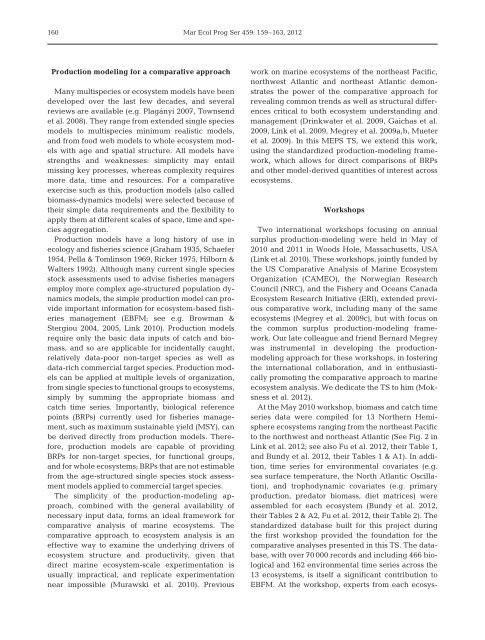Complete Theme Section in pdf format - Inter Research
Complete Theme Section in pdf format - Inter Research
Complete Theme Section in pdf format - Inter Research
Create successful ePaper yourself
Turn your PDF publications into a flip-book with our unique Google optimized e-Paper software.
160<br />
Mar Ecol Prog Ser 459: 159–163, 2012<br />
Production model<strong>in</strong>g for a comparative approach<br />
Many multispecies or ecosystem models have been<br />
developed over the last few decades, and several<br />
reviews are available (e.g. Plagányi 2007, Townsend<br />
et al. 2008). They range from extended s<strong>in</strong>gle species<br />
models to multispecies m<strong>in</strong>imum realistic models,<br />
and from food web models to whole ecosystem models<br />
with age and spatial structure. All models have<br />
strengths and weaknesses: simplicity may entail<br />
miss<strong>in</strong>g key processes, whereas complexity requires<br />
more data, time and resources. For a comparative<br />
exercise such as this, production models (also called<br />
biomass-dynamics models) were selected because of<br />
their simple data requirements and the flexibility to<br />
apply them at different scales of space, time and species<br />
aggregation.<br />
Production models have a long history of use <strong>in</strong><br />
ecology and fisheries science (Graham 1935, Schaefer<br />
1954, Pella & Toml<strong>in</strong>son 1969, Ricker 1975, Hilborn &<br />
Walters 1992). Although many current s<strong>in</strong>gle species<br />
stock assessments used to advise fisheries managers<br />
employ more complex age-structured population dynamics<br />
models, the simple production model can provide<br />
important <strong>in</strong><strong>format</strong>ion for ecosystem- based fisheries<br />
management (EBFM; see e.g. Browman &<br />
Stergiou 2004, 2005, L<strong>in</strong>k 2010). Production models<br />
require only the basic data <strong>in</strong>puts of catch and biomass,<br />
and so are applicable for <strong>in</strong>cidentally caught,<br />
relatively data-poor non-target species as well as<br />
data-rich commercial target species. Production models<br />
can be applied at multiple levels of organization,<br />
from s<strong>in</strong>gle species to functional groups to ecosystems,<br />
simply by summ<strong>in</strong>g the appropriate biomass and<br />
catch time series. Importantly, biological reference<br />
po<strong>in</strong>ts (BRPs) currently used for fisheries management,<br />
such as maximum susta<strong>in</strong>able yield (MSY), can<br />
be derived directly from production models. Therefore,<br />
production models are capable of provid<strong>in</strong>g<br />
BRPs for non-target species, for functional groups,<br />
and for whole ecosystems; BRPs that are not estimable<br />
from the age-structured s<strong>in</strong>gle species stock assessment<br />
models applied to commercial target species.<br />
The simplicity of the production-model<strong>in</strong>g ap -<br />
proach, comb<strong>in</strong>ed with the general availability of<br />
necessary <strong>in</strong>put data, forms an ideal framework for<br />
comparative analysis of mar<strong>in</strong>e ecosystems. The<br />
comparative ap proach to ecosystem analysis is an<br />
effective way to exam<strong>in</strong>e the underly<strong>in</strong>g drivers of<br />
ecosystem structure and productivity, given that<br />
direct mar<strong>in</strong>e ecosystem-scale experimentation is<br />
usually impractical, and replicate experimentation<br />
near impossible (Mu raws ki et al. 2010). Previous<br />
work on mar<strong>in</strong>e ecosystems of the northeast Pacific,<br />
northwest Atlantic and northeast Atlantic demonstrates<br />
the power of the comparative approach for<br />
reveal<strong>in</strong>g common trends as well as structural differences<br />
critical to both ecosystem understand<strong>in</strong>g and<br />
management (Dr<strong>in</strong>kwater et al. 2009, Gaichas et al.<br />
2009, L<strong>in</strong>k et al. 2009, Me grey et al. 2009a,b, Mueter<br />
et al. 2009). In this MEPS TS, we extend this work,<br />
us<strong>in</strong>g the standardized production-model<strong>in</strong>g framework,<br />
which allows for direct comparisons of BRPs<br />
and other model-derived quantities of <strong>in</strong>terest across<br />
ecosystems.<br />
Workshops<br />
Two <strong>in</strong>ternational workshops focus<strong>in</strong>g on annual<br />
surplus production-model<strong>in</strong>g were held <strong>in</strong> May of<br />
2010 and 2011 <strong>in</strong> Woods Hole, Massachusetts, USA<br />
(L<strong>in</strong>k et al. 2010). These workshops, jo<strong>in</strong>tly funded by<br />
the US Comparative Analysis of Mar<strong>in</strong>e Ecosystem<br />
Organization (CAMEO), the Norwegian <strong>Research</strong><br />
Council (NRC), and the Fishery and Oceans Canada<br />
Ecosystem <strong>Research</strong> Initiative (ERI), extended previous<br />
comparative work, <strong>in</strong>clud<strong>in</strong>g many of the same<br />
ecosystems (Megrey et al. 2009c), but with focus on<br />
the common surplus production-model<strong>in</strong>g framework.<br />
Our late colleague and friend Bernard Megrey<br />
was <strong>in</strong>strumental <strong>in</strong> develop<strong>in</strong>g the productionmodel<strong>in</strong>g<br />
approach for these workshops, <strong>in</strong> foster<strong>in</strong>g<br />
the <strong>in</strong>ternational collaboration, and <strong>in</strong> enthusiastically<br />
promot<strong>in</strong>g the comparative approach to mar<strong>in</strong>e<br />
ecosystem analysis. We dedicate the TS to him (Moksness<br />
et al. 2012).<br />
At the May 2010 workshop, biomass and catch time<br />
series data were compiled for 13 Northern Hemisphere<br />
ecosystems rang<strong>in</strong>g from the northeast Pa ci fic<br />
to the northwest and northeast Atlantic (See Fig. 2 <strong>in</strong><br />
L<strong>in</strong>k et al. 2012; see also Fu et al. 2012, their Table 1,<br />
and Bundy et al. 2012, their Tables 1 & A1). In addition,<br />
time series for environmental covariates (e.g.<br />
sea surface temperature, the North Atlantic Oscillation),<br />
and trophodynamic covariates (e.g. primary<br />
production, predator biomass, diet ma tric es) were<br />
assembled for each ecosystem (Bundy et al. 2012,<br />
their Tables 2 & A2, Fu et al. 2012, their Table 2). The<br />
standardized database built for this project dur<strong>in</strong>g<br />
the first workshop provided the foundation for the<br />
comparative analyses presented <strong>in</strong> this TS. The database,<br />
with over 70 000 records and <strong>in</strong>clud<strong>in</strong>g 466 biological<br />
and 162 environmental time series across the<br />
13 ecosystems, is itself a significant contribution to<br />
EBFM. At the workshop, experts from each ecosys-
















